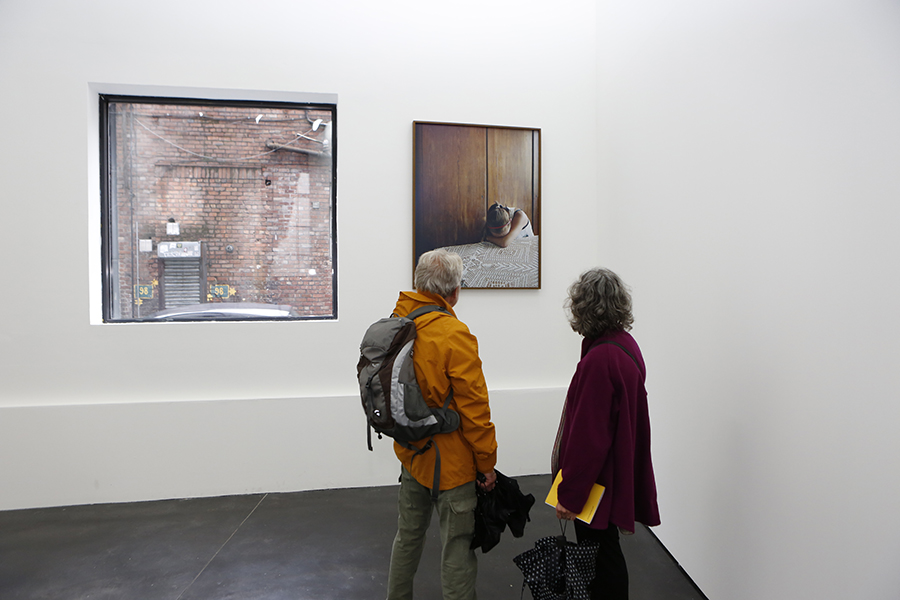Biennial 2014: The Space In Between

Notice anything different? C James Fagan realises that Liverpool Biennial is changing the space around us, and therefore, he argues, the expectation of the visitor…
There’s a lot of space in FACT. The artist Sharon Lockhart has opened part of the foyer and uncovered a hidden window. If this were one of those ‘Sell Your House’ TV shows, we’d be talking about how it really opens up the space. It might be trite but it’s true: the vibe is different. It’s not just a case of something else on the wall.
My relationship with that space has changed.
In that spot, you have an encapsulation of this year’s Liverpool Biennial: A Needle Walks Into A Haystack. Though this time, it appears to be more of a guideline than a theme (there is no official theme). This Biennial seems to be centred on ideas of liminality, and the everyday architecture of routine and habit that make up the bulk of our lives. After an initial visit to the big festival venues, it seems that they haven’t strictly adhered to his idea. They’ve floated around it curated works and artists whose work doesn’t exactly match the brief.
This could all be for the better.
Returning to Sharon Lockhart as a case in point, in order to describe her work, I’d have to explain about her careful documentation of Polish children at play and how this led to the development of a relationship with a particular girl (Milena). This forms the core of Lockhart’s work; what it doesn’t describe are the works’ spatial qualities. Her static films and photographs show a world set within a frame: a cropped vision of society.
The emphasis is on how the subjects move through space, rather than the movement of the camera and the editing. Watching the children through this narrow spectrum, you begin to get the sense that these are human beings under the influence of unseen systems. Of unwritten rules, both internal and external, that govern their actions, and that makes them part of the architecture that surrounds them.
In the upstairs gallery, Lockhart present the basic shape of a gallery: like this is the bare minimum you need to have a gallery experience as a visitor. It’s an example of the idea of architectural space, buildings, habits, etiquette — however you describe the differing layers of soft control that nudge your life one way or another.

Space and how you interact with it has been an element of Liverpool Biennial for a while. For the last three festivals, large landmark buildings have been commandeered: Pilkington’s Warehouse (2008), Rapid DIY store (2010), the Cunard and the behemoth ex-Post Office warehouse (2012). This Biennial has inhabited the dusty skeleton of the Old Blind School on Hardman Street.
It is as much out of necessity to utilise the city’s assets, as it is a Biennial with no fixed abode. It does, however, welcome a different type of visitor; one who has a direct connection with a former incarnation of the building. Or simply someone who wants to nose around. Any art is incidental.
A curatorial pre-occupation with space is more pronounced this year. For example, Michael Stevenson’s sets of grey institutional doors which lock and unlock themselves to some unknown door lore. Or the torn-away wall of William Leavitt’s Arctic Earth, offering a view of the planet through patio doors. Both works are a playful way of re-evaluating our interaction with the built environment, and all the little rules underlining their liminal ubiquity, their ‘everydayness’.
Down the road from the Old Blind School, Claude Parent’s reworking of Tate Liverpool’s ground floor gallery space is a playful mix of expressionistic ramps and ’60s sci-fi set; the architect has set out to remove the sense of polite, distant observation you can fall into when wandering around a gallery. Being almost flung into a sculpture, or having to climb to see a painting, is a clip around the ear to remind you that you’re an active — not passive — participant.
An alteration of a space leads to an alteration of behaviour.
Approaches to how art is viewed also surface at The Bluecoat, who have chosen to follow the dictates of Whistler. The antagonistic artist had clear ideas about the ambiance his works should be shown within, even down to choosing the clothes that invigilators should wear. This manifests itself through use of pastel colours on the walls, canopies and defused lighting. It may be to too subtle; it’s not as radical as Parent’s ramps, but it does provide a different experience within the boundaries of a familiar community art gallery.
If this Biennial is chasing an idea of questioning our relationship with the everyday, then it has done it through the adaptation of the space used to exhibit the work itself. As a viewer of art, you can slip into a system of liminality, of expecting art to exist in the space of a white cube. When confronted by a gallery stripped to its bare minimum or bathed in soft light, even walking through abandoned offices, it becomes necessary to reconsider your behaviour, expectations and, indeed, your role as viewer.
While I cannot claim that Liverpool Biennial 2014 is 100% successful , I have found something within it that many haven’t. Perhaps it lies within this year’s unofficial theme being a guideline rather than strict doctrine; this has seemed to enable the galleries and curators to freely explore that theme and use work which opens up a dialogue about the role of gallery and visitor.
The lack of ‘dictatorial curation’ makes the whole thing feel more cohesive and somehow more successful.
It might be a paradox, but it’s a welcome one.
C James Fagan
Liverpool Biennial continues until 26 October. Look out for talks, fringe events and performances on the site – www.biennial.com/2014
Read other articles by C James Fagan here
Biennial 2014: What Peter Wächtler Has To Say About Liverpool





